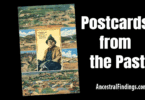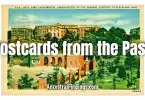I pulled this one from the stack and couldn’t look away. Moss hangs low in the scene, soft and heavy like it’s weighed down by memory. A quiet glade in City Park, dappled in sunlight—until you notice the duel: two men, swords drawn, captured mid-motion. The postcard tells us it’s the De Lissau–Le Bouisque duel of 1841. But that’s only the beginning.
What you’re seeing is more than just a stylized illustration. This postcard opens a window into one of New Orleans’ more haunting traditions: dueling. For over a century, a particular corner of City Park—shaded by massive oak trees—was the chosen ground for resolving matters of honor. They called them the Dueling Oaks.
These weren’t just personal scuffles. In the 1800s, dueling was a common practice among certain social classes. It followed the rules, often drawn from the Code Duello, a formal guide for resolving disputes with swords or pistols. Men came here with seconds, surgeons, and sometimes spectators. And when the sun rose over those oaks, some of them didn’t leave alive.
“In one Sunday alone during the year 1837, ten duels were fought under these trees. Emile La Sère, a U.S. Congressman from New Orleans, is said to have fought eighteen duels in this historic spot. Micajah Lewis, Secretary to Governor Claiborne, was killed here in 1804.”
That’s printed right on the back of the card. It reads like a quiet warning carved into time—one that was sent, received, and perhaps never spoken of again.
And these weren’t isolated stories. Congressman Emile La Sère’s eighteen duels speak volumes about how deeply embedded this tradition was. Micajah Lewis, killed in a duel in 1805, was the brother-in-law and private secretary to Governor William C.C. Claiborne. These were men whose names still echo in Louisiana’s records—land deeds, legal documents, maybe even the pages of your family’s past.
That’s what makes a postcard like this so interesting. For someone researching genealogy, it’s not just a quaint old picture—it’s a door. Maybe your ancestor wasn’t one of the duelists. But what about a second? A physician? A witness? Someone who stood in the background, arms crossed, eyes steady, and carried the story home in silence.
Dueling in New Orleans eventually faded, pushed out by changing values, new laws, and the advent of more deadly weapons. The last duels were more scandal than honor, and by the 1890s, the tradition was all but gone. The second of the Dueling Oaks was lost to a hurricane in the 1940s. Today, only one tree remains, quietly standing near the New Orleans Museum of Art—its limbs still stretching as if listening.
If you ever find yourself there, stop beneath it. Let the breeze move the moss above you and think for a moment about the people who once stood here—people who believed their names, their reputations, and even their futures rested on what happened beneath these branches.
This postcard holds all of that in a quiet sort of way. It doesn’t explain—it invites you to remember. Or maybe to start searching.
If you’ve got a postcard tucked away—something curious, mysterious, or meaningful—why not send it in? I’d love to see it, and it might just be featured in a future episode of Postcards from the Past. You can send me a postcard by clicking on the “Contact“ link to request my mailing address.






